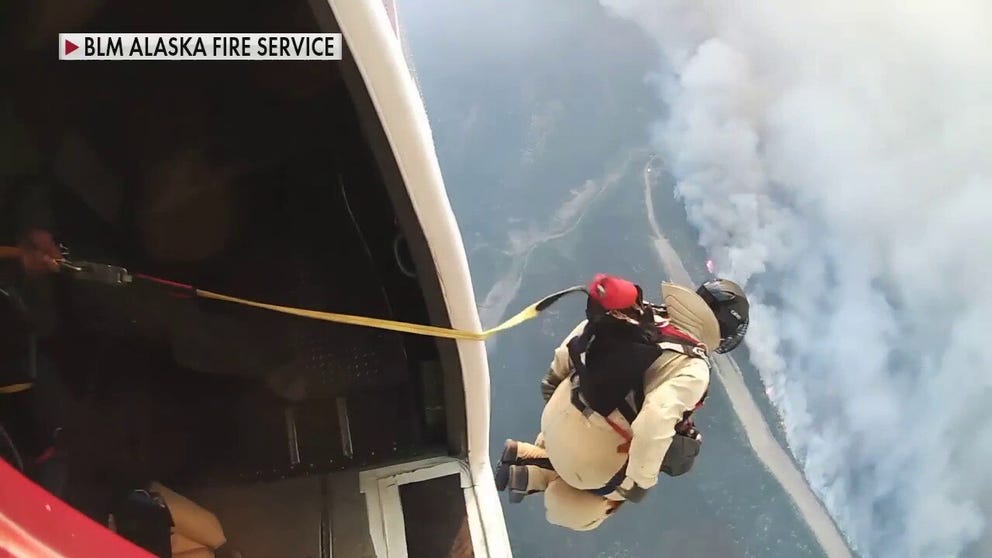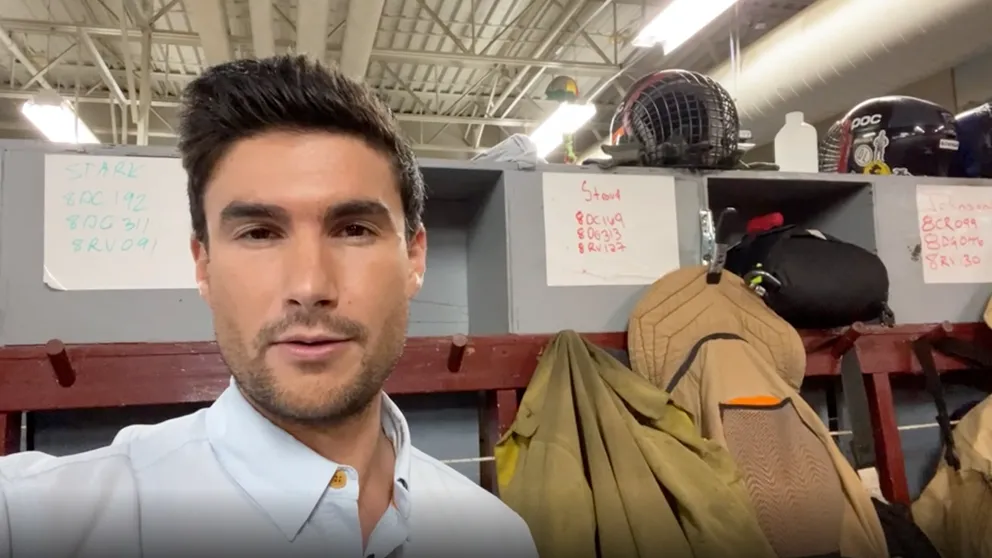Help from above: Drop into wildfires with Alaska’s elite smokejumpers
While there are smokejumpers throughout the country, things are a little different in Alaska
Drop into wildfires with Alaska's elite smokejumpers
Alaska has vast stretches of wild, open country and is often called the last frontier. So, what happens when wildfires break out? Sometimes the best way to attack the flames is for firefighters to parachute in.
FAIRBANKS, Alaska -- It takes a particular type of person to jump out of airplanes for a living, and it takes a whole other level of ruggedness to fight fire in Alaska’s wilderness when their feet touch the ground.
"It’s loud. There’s a lot of wind. We have a five-second free fall from 3,000 feet," said Andrew Gavin, a smokejumper with the Alaska Fire Service. "We deploy our parachute. From there, we do our checks. Make sure we have a good canopy."
Gavin, who has been a smokejumper for seven years, said there is no other place he would rather be than in the wilderness.
"We are an air-deployed resource for the state of Alaska, and we will mainly protect native allotments and villages or structures inside the interior of Alaska," he said.
Gavin and his fellow smokejumpers are tasked with fighting fires in some of the most remote regions of the U.S.
"We’ll be out deep into the bush. We’ll be hundreds of miles away sometimes from people," he said.
While there are smokejumpers throughout the country, things are a little different in Alaska.
"We jump with a lot more gear to fight fire because the ecosystem here is totally different than the lower 48," Gavin said.
Max Gorden reports from Fairbanks, Alaska
Max Gorden journeyed to Fairbanks, Alaska, to meet the specialized firefighters known as smokejumpers.
Alaskan smokejumpers have to be self-sufficient
Smokejumpers in the rest of the U.S. usually only fight fire with hand tools. Alaskan smokejumpers deploy with pumps and hose packs because of an abundance of water and soil that’s knotted with roots and tough to dig fire lines through.
"Water makes everything 10 times easier, and up here, there’s so much water just from ice melt and from all the river systems that fires are near," Gavin said.
The crews have to be self-sufficient. Once the eight-man teams drop into a fire zone, they make camp out in the bush.
"Typically, we’ll take one of the cargo chutes, hang that kind of as our shelter," Gavin said.
Their equipment comes to them the same way they got to the scene: dropped out of the back of an airplane.
"(It's) one of the operations that we do up here. We probably throw the most Paracargo in the world," Gavin said.
They drop everything from food to four-wheelers for firefighters. However, these Paracargo operations come with their dangers.
"Because we can throw palettes that are up to 1,500 pounds, and if that were to somehow go wrong – if it gets tied up to the back of the plane, or the parachutes don’t deploy, then you have a 1,500-pound load on the back of the tailgate either dragging the airplane to the ground or going to the ground where there are people, and it’s basically an ordinance at that moment," Gavin said.
It’s a necessity in a land mainly without roads.
"Our Paracargo program actually supplies almost any fire operation up here," Gavin said.
Self-sufficiency is vital for the smokejumpers. After a jump, they hang and inspect their parachutes. They also do a lot of their repairs themselves.
"There’s a lot of maintenance that goes into these," Gavin said.
It’s all done at their headquarters in Fairbanks that the smokejumpers jokingly call "The Box."
The way fires burn in Alaska is changing
During Alaska’s fire season, at least four jump aircraft are stationed around the state, operated by around 70 smokejumpers. When the rain moves in, the aircraft and crew move out to the lower 48 to fight fires there.
"When we slow down in Alaska, requests will be put in, requests will be put in from various bases supplementing their personnel," said Bill Cramer, chief of the Alaska smokejumpers.
Cramer has been smokejumping for 32 years and an Alaska jumper for 28 of those.
"I started out at Boise BLM jump base. It’s been an incredible career, an incredible experience. I’ve got five more years left if the body holds together," Cramer said.
Through his years as a smokejumper, Cramer said the workload has gone up, and the way fires burn in Alaska is changing.
"There’s less predictability about the seasons. You’re seeing fires burning in locations that weren’t as common. Like in 2019, we had fires in the southern part of the state. Which typically, we’d have some in the spring, a little bit. But the scale of it, on our bigger years, is almost unprecedented," he said.
Cramer said places that usually don’t burn in Alaska are now at risk.
"I do personally think that climate change is a factor in that. I think that some of the stuff that you’ve seen -- both nationally and in Alaska -- is directly related to a changing climate. I don’t think you can point to one individual season, but collectively it does seem like it’s getting to a point where there’s less predictability, and we can’t rely on our historic norms," Cramer said.
The next generation
With these growing challenges, Cramer is tasked with mentoring the next generation of smokejumpers.
"A lot of the enjoyment of the job comes from the variety of people you get to work with. They’re just tremendous human beings. There are Olympic-caliber athletes; there are folks that have Ph.D.s. I mean, it’s a whole spectrum," he said.
As times change, that is what has stayed the same among Alaska’s smokejumpers.
"People (are) probably the best part about it … more like a brotherhood," Gavin said. "If I’m not working as hard as they are, then I’m not doing my job justice."
It’s a reliance on capable, hard-working individuals and a team all willing to do a task that others might think is crazy.

